Abstract
The introduction of exogenous glutamate to normally respiring hippocampal slices produced substantial reductions in ATP, phosphocreatine (PCr) and intracellular pH (pHi) when the concentration exceeded 1 mM. These changes were not prevented by addition of MK-801 (an NMDA receptor antagonist), nor were they mimicked by NMDA or high potassium. In addition, the glutamate-induced metabolic alterations were not prevented by addition of aspartate-b-hydroxymate or sodium substitution by choline, both of which should inhibit high-affinity sodium-dependent glutamate uptake. These results suggest that glutamate alone can produce marked energetic stress in neural tissue, even when glucose and oxygen are maintained at control levels; and that the energetic stress does not appear to be specifically mediated by NMDA-induced depolarization, or by high-affinity uptake of glutamate.
Similar content being viewed by others
References
Assaf, H.M., Ricci, A.J., Whittingham, T.S., LaManna, J.C., Ratcheson, R.A. and Lust, W.D. (1990) Lactate compartmentation in hippocampal slices: evidence for a transporter.Metab. Brain Disease 5: 143–154.
Bradford, H.F., Young, A.M.J. and Crowder, J.M. (1987) Continuous glutamate leakage from brain cells is balanced by compensatory high-affinity reuptake transport.Neurosci. Lett. 81: 296–302.
Choi, D.W. (1988) Calcium-mediated neurotoxicity: relationship to specific channel types and role in ischemic damage.Trends Neurosci. 11: 465–469.
Choi, D.W., Maulucci-Gedde, M., and Kriegstein, A.R. (1987) Glutamate neurotoxicity in cortical cell culture.J. Neurosci. 7: 357–368.
Choi, D.W. and Rothman, S.M. (1990) The role of glutamate neurotoxicity in hypoxic-ischemic neuronal death.Ann. Rev. Neurosci. 13: 171–182.
Clark, G.D. and Rothman, S.M. (1987) Blockade of excitatory amino acids receptors protects anoxic hippocampal slices.Neuroscience 21: 665–671.
Fonnum, F. (1984) Glutamate: a neurotransmitter in mammalian brain.J. Neurochem. 42: 1–11.
Foster, A.C., Gill, R., Kemp, J.A. and Woodruff, G.N. (1987) Sytemic administration of MK-801 prevents N-methyl-D-aspartate-induced neuronal degeneration in rat brain.Neurosci. Lett. 76: 307–311.
Gill, R., Foster, A.C., and Woodruff, G.N. (1987) Systemic administration of MK-801 protects against ischemia-induced hippocampal neurodegeneration in the gerbil.J. Neurosci. 7: 3343–3349.
Globus, M.Y.-T., Busto, R., Dietrich, W.D., Martinez, E., Valdes, I. and Ginsberg, M.D. (1988) Effect of ischemia on thein vivo release of striatal dopamine, glutamate, and m-aminobutyric acid studied by intracerebral microdialysis.J. Neurochem. 51: 1455–1464.
Ikeda, M., Nakazawa, T., Abe, K., Kaneko, T. and Yamatsu, K. (1989) Extracellular accumulation of glutamate in the hippocampus induced by ischemia is not calcium dependent —in vitro andin vivo evidence.Neurosci. Lett. 96: 202–206.
Kauppinen, R.A., McMahon, H.T. and Nicholls, D.G. (1988) Ca2+-dependent and Ca2+-independent glutamate release, energy status and cytosolic free Ca2+ concentration in isolated nerve terminals following metabolic inhibition: Possible relevance to hypoglycaemia and anoxia.Neuroscience 27: 175–182.
Kihara, M., Misu, Y. and Kubo, T. (1989) Release by electrical stimulation of endogenous glutamate, m-aminobutyric acid, and other amino acids from slices of the rat medulla oblongata.J. Neurochem. 52: 261–267.
Lowry, O.K., Rosebrough, N.J., Farr, A.L. and Randall, R.J. (1951) Protein measurement with the folin phenol reagent.J. Biol. Chem. 193: 265–275.
Lowry, O.H. and Passonneau, J.V. (1972)A Flexible System of Enzymatic Analysis, Academic Press, New York.
Lust, W.D., Feussner, G.K., Barbehenn, E.K. and Passonneau, J.V. (1981) The enzymatic measurement of adenine nucleotides and P-creatine in picomole amounts.Anal. Biochem. 110: 258–266.
MacMillan, V. and Siesjo, B.K. (1972) Intracellular pH of the brain in arterial hypoxemia evaluated with the CO2 method and from the creatine phosphokinase equilibrium. Scand.J. Clin. Lab. Invest. 30: 117–125.
Nellgard, B. and Wieloch, T. (1992) Postischemic blockade of AMPA but not NMDA receptors mitigates neuronal damage in the rat brain following transient severe cerebral ischemia.J. Cereb. Blood Flow 12: 2–11.
Nicholls, D.G., Sihra, T.S., and Sanchez-Prieto, J. (1987) Calcium dependent and independent release of glutamate from synaptosomes monitored by continuous fluorometry.J. Neurochem. 49: 50–57.
Park, C., Nehls, D.G., Ozyurt, E., Graham, D.I., and McCulloch, J. (1987) Ischemic brain damage is reduced by systemic administration of the N-methyl-D-aspartate (NMDA) antagonist, MK-801.Soc. Neurosci. Abstr. 13: 1029.
Rothman, S. M. (1983) Synaptic activity mediates death of hypoxic neurons.Science 220: 536–537.
Rothman, S.M. and Olney, J.W. (1986) Glutamate and the pathophysiology of hypoxic-ischemic brain damage.Ann. Neurol. 19: 105–111.
Rothman, S.M. and Olney, J.W. (1987) Excitotoxicity and the NMDA receptor.Trends Neurosci. 10: 299–302.
Rothman, S.M., Thurston, J.H., Hauhart, R.E., Clark, G.D. and Soloman, J.S. (1987) Ketamine protects hippocampal neurons from anoxiain vitro. Neuroscience21: 673–678.
Siesjo, B.K. (1988) Historical overview. Calcium, ischemia, and death of brain cells.Ann. N.Y. Acad. Sci. 522: 638–661.
Siesjo, B.K. and Bengtsson, F. (1989) Calcium fluxes, calcium antagonists, and calcium-related pathology in brain ischemia, hypoglycemia, and spreading depression: a unifying hypothesis.J. Cereb. Blood Flow Metab. 9: 127–140.
Szatkowski, M., Harbour, B., and Attwell, D. (1990) Non-vesicular release of glutamate from glial cells by reversed electrogenic glutamate uptake.Nature 348: 443–446.
Yamamoto, B.K. and Davy, S. (1992) Dopaminergic modulation of glutamate release in striatum as measured by microdialysis.J. Neurochem. 58: 1736–1742.
Author information
Authors and Affiliations
Rights and permissions
About this article
Cite this article
Whittingham, T.S., Assaf, H., Selman, W.R. et al. Glutamate-induced energetic stress in hippocampal slices: Evidence against NMDA and glutamate uptake as mediators. Metabolic Brain Disease 7, 77–92 (1992). https://doi.org/10.1007/BF01000147
Received:
Accepted:
Issue Date:
DOI: https://doi.org/10.1007/BF01000147




